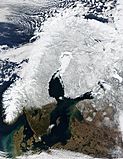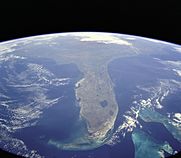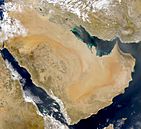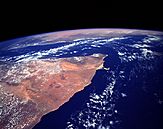Peninsula facts for kids
A peninsula is a piece of land that sticks out from a mainland. It has water on most, but not all, of its sides. You can think of it as land that's almost an island! Many people simply say a peninsula is land surrounded by water on three sides.
You can find peninsulas on every continent. They come in all sizes, from tiny bits of land to huge areas. The biggest peninsula in the world is the Arabian Peninsula. Peninsulas are formed in many different ways, which we'll explore below!
Contents
What's in a Name?
The word "peninsula" comes from Latin. It's from the word "paeninsula," which means 'almost an island'. This makes a lot of sense, right? The word first came into the English language in the 1500s.
What Makes a Peninsula?
A peninsula is usually defined as a piece of land with water on most of its sides. But it is still connected to a larger landmass. This water doesn't always have to be an ocean or a sea!
For example, a piece of land on a very tight bend in a river can be a peninsula. Land between two rivers can also be called a peninsula. An example of this is the New Barbadoes Neck in New Jersey, United States.
Sometimes, a peninsula connects to the mainland by a narrow strip of land. This strip is called an isthmus. A famous example is the isthmus of Corinth. It connects to the Peloponnese peninsula in Greece.
How Do Peninsulas Form?
Peninsulas can form because of many natural processes. These include continental drift (when continents slowly move) and erosion by glaciers. Meltwater from glaciers and sediment left behind by them also play a role. Marine sediment (stuff that settles at the bottom of the ocean) can also create them.
Changes in sea level (called marine transgressions) can form peninsulas. Volcanoes and even sedimentation from rivers can too. Often, more than one of these factors works together. For instance, the shape of Florida was influenced by continental drift, marine sediment, and changes in sea level.
Glaciers and Peninsulas
Glaciers are huge, slow-moving rivers of ice. They can dramatically change the land. They can create peninsulas in a few ways:
Erosion by Glaciers
If a peninsula was formed by glacial erosion, it means the glacier carved away softer rocks. It left harder rocks behind. This carving can create a basin (a dip in the land). It leaves land sticking out, forming a peninsula. The Keweenaw Peninsula is an example of this.
Meltwater and Moraines
When glaciers melt, they leave behind piles of sediment. These piles are called moraines. Moraines can act like natural dams. They trap meltwater and create new bodies of water. This water then surrounds land, forming peninsulas.
Glacial Deposition
Sometimes, a peninsula forms when a glacier deposits a lot of glacial drift (rock and sediment). If this pile of drift forms near water but stays connected to the mainland, it becomes a peninsula. This is how Cape Cod in the United States was formed about 23,000 years ago.
Other Ways Peninsulas Are Made
Volcanoes and Magma
When a volcano erupts magma (molten rock) near water, the cooling lava can build up. This can form a peninsula. The Alaskan Peninsula is an example of a peninsula formed this way.
Marine Sediment and Limestone
Marine sediment can also form peninsulas. Over long periods, layers of sediment can build up. They harden into rock, like limestone. This creates new land that extends into the water.
Earth's Moving Plates
The movement of Earth's massive plates, called plate tectonics, can also create peninsulas. When plates pull apart (a divergent boundary), it can lead to a rift. This rift helped form the Arabian Peninsula. When plates push together (a convergent boundary), it can also create peninsulas. Examples include Gibraltar or the Indian subcontinent.
River Sedimentation
Rivers carry a lot of sediment (like sand and mud). When a river flows into an ocean or a large lake, it slows down. It then drops this sediment. This forms a triangular piece of land called a delta. If this delta sticks out into the water, it can become a delta peninsula.
How Sea Level Changes Affect Peninsulas
Changes in sea level can both create peninsulas and affect existing ones. If the water level rises a lot, a peninsula might become an island temporarily. During very wet weather, higher water levels can make peninsulas appear smaller. Dry weather can make them look larger. Over time, rising sea levels will permanently reduce the size of some peninsulas.
Why Are Peninsulas Important?
Peninsulas have been useful to humans for a long time. They offered good places for people to live. They provided access to both land animals for hunting and sea creatures for fishing. Peninsulas can also serve as natural markers for a country's borders.
Want to Learn More?
See also
 In Spanish: Península para niños
In Spanish: Península para niños
- Barrier island
- Cape
- Headland
- Promontory
- Salient
- Spit





